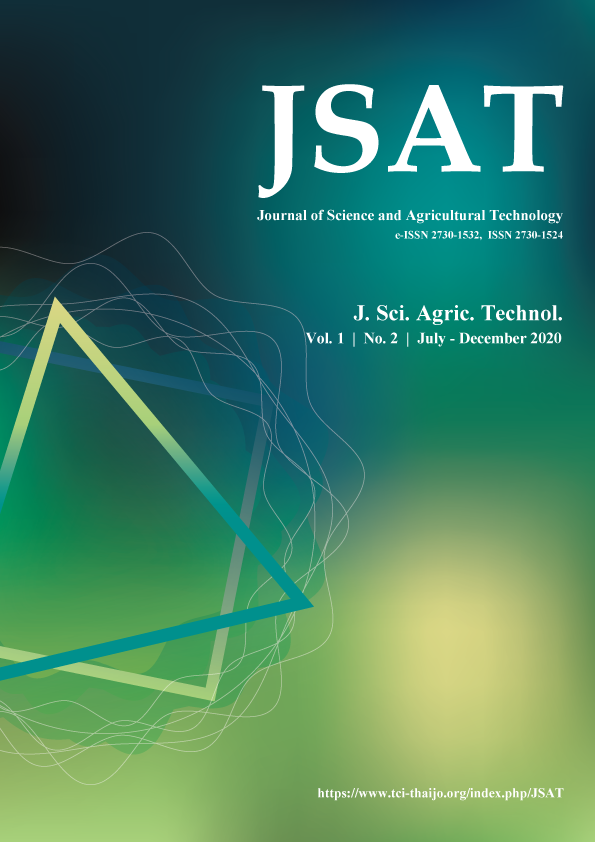Small RNA sequencing studies of populations of plant virus families in tropical rainforest of Xishuangbanna
Main Article Content
Abstract
The tropical rainforest of Xishuangbanna has the most abundant and cryptic plant species biodiversity in China. To explore the populations of plant virus families in Xishuangbanna tropical rainforests, fifteen pools of plant samples from different forest locations were collected and used for small RNA analyses by high throughput sequencing. All contigs were classified and annotated with the NCBI Nt database to determine the species distributions, and comparisons were conducted using the Blast algorithm. The viral sequences in the Clean Reads were compared with the relevant sequences, using the Kraken software system, to infer their possible classification and to analyze the abundance of each species statistically. The number of Clean reads of every pool sample was from 1573897 to 26878598, and the average number of Clean reads was 20322116. The average number of clean reads is taken as 0.0036% from the average number of Raw reads. The results from a total of 3703 viral sequences were annotated, and these represented a total of 16 plant virus families. Among these, 1952 Geminiviridae sequences comprised the dominant annotated virus proportion. 732 sequences belonged to the Potyviridae, and 192 sequences were characteristic of members of the Caulimoviridae. The viral sequences primarily originated from dicots and monocotyledonous plants, including herbaceous and woody plants. Generally, the total viral sequences from herbaceous plants represented 66.7 %, and 33.3 % were from woody plants, and amongst these, 57.1% dicots represented the plant hosts, whereas 42.9 % were derived from monocotyledonous families. The presumptive Geminiviridae and Potyviridae viruses have broad host ranges, and different families were annotated from each sample site in Xishuangbanna. This study lays a foundation for future research on the evolution and utilization of viruses within tropical rainforests and those of cultivated agricultural areas.
Article Details
References
Ge, X., Wu, Y., and Wang, M. 2013. Viral metagenomics analysis of planktonic viruses in East Lake, Wuhan, China. Virol Sin. 28: 280-290.
Grover, V., Pierce, M.L., and Hoyt, P. 2010. Oligonucleotide-based microarray for detection of plant viruses employing sequence-independent amplification of targets. J. Virol. Methods. 163:57-67.
Hong, J, Li, D.B., and Zhou, X.P., 2001. Classification Map of Plant Viruses, Science Press. p.101-198.
Korf, I., Yandell, M., and Bedell, J.A. 2003. BLAST - an essential guide to the basic local alignment search tool. DBLP. 36:117-119.
Ma, Y.X., and Li, S.F. 2016. Application of high-throughput sequencing technology in identification of woody plant Geminiviruses. Plant Protection. 42(6):1-10.
Marquez, L.M., Redman, R.S., Rodriguez, R.J., and Roossinck, M.J. 2007. A virus in a fungus in a plant: three-way symbiosis required for thermal tolerance. Science. 315:513-515.
Min, B.E., Feldman, T.S., and Ali, A. 2012. Molecular characterization, ecology, and epidemiology of a novel Tymovirus in Asclepias viridis from Oklahoma. Phytopathology. 102: 166-76.
Muthukumar, V., Melchera, U., Pierce, M., Wiley, G.B., Roe, B.A., Palmer, M.W., Thapa, V., Ali, A., and Ding, T. 2009. Non-cultivated plants of the Tallgrass Prairie Preserve of northeastern Oklahoma frequently contain virus-like sequences in particulate fractions. Virus Res, 141:169–173.
Owens, R.A., Flores, R., Di Serio, F., Li, S-F., Pallás, V., Randles, J.W., Sano, T. and Vidalakis, G. 2012. Virus Taxonomy: Ninth Report of the International Committee on Taxonomy of Viruses. Academic Press. Chapter: Part II p. 1221-1234.
Roossinck, M. J. 2005. Symbiosis versus competition in plant virus evolution, Nat Rev Microbiol. 3(12):917-924.
Roossinck, M.J. 2010. Lifestyles of plant viruses. Philosophical Transactions of the Royal Society of London, 365: 1899-1905.
Roossinck, M.J., Saha, P., and Wiley, G.B. 2010. Ecogenomics: using massively parallel pyrosequencing to understand virus ecology. Mol Ecol. 19: 81-88.
Roossinck, M.J. 2011. The big unknown: plant virus biodiversity. Curr Opin Virol. 1: 63-67.
Roossinck, M.J. 2011. The good viruses: viral mutualistic symbioses. Nat. Rev. Microbiol. 9: 99-108.
Roossinck, M. J. 2012. Plant virus metagenomics: biodiversity and ecology. Annu. Rev. Genet. 46: 359.
Scheets, K., Blinkova, O., and Melcher, U. 2011. Detection of members of the Tombusviridae, in the tallgrass prairie preserve, Osage County, Oklahoma, USA. Virus Res. 16:256-263.
Vaskar, T., Mcglinn, D., and Ulrich, M. 2015. Determinants of taxonomic composition of plant viruses at the Nature Conservancy’s Tallgrass Prairie Preserve, Oklahoma. Virus Evol. 1(1) vev007.
Wei, B. 2012. Diversity and distribution of proteorhodopsin-containing microorganisms in marine environments. Front. Environ. Sci. Eng. 6:98-106.
Wood, D., and Kraken, S.S. 2014. Ultrafast metagenomic sequence classification using exact alignments. Genome Biol. 15: R46.
Yan, X., Zhou, X.P., and Zhang, Z.K. 2002. Yijun Qi,Tobacco curly shoot virus isolated in Yunnan is a distinct species of Begomovirus. Chin. Sci. Bull. 47(3):199–201.
Yang, F., Wang, Y., and Zheng, W. 2013. Metagenomic analysis of bat virome in several Chinese regions. Chin J Biotechnol. 29:586-600.
Yang, Z. 2011. Study on the current situation and protection countermeasures of wild plant resources in Xishuangbanna National Nature Reserve. Meteorological and Environmental Research. 2:79-82.
Yang, X. L., Yan, X., Raja, P., Li, S. Z., Wolf, J.N., Shen, Q.T., David, M. Bisaro, D.M., and Zhou, X.P. 2011. Suppression of Methylation-Mediated Transcriptional Gene Silencing by βC1-SAHH Protein Interaction during Geminivirus-Betasatellite Infection, PLOS Pathogens, Published: October 20,https://doi.org/10.1371/journal.ppat.1002329
Zerbino, D.R. 2010. Using the velvet de novo assembler for short‐read sequencing technologies[J]. Current protocols in bioinformatics. John Wiley & Sons, Inc. chapter 11: Unit 11.5-Unit 11.5.
Zhang, Z.K., and Li, Y. 2001. Yunnan Plant Virus, Science Press, Chapter 3:45.
Zhang, Z.K. 2010. Geographical distribution of geminivirus population in Yunnan province and its impact on disease occurrence and damage. Master's Thesis, Chinese Academy of Agricultural Sciences. 1-7.
Zhang, Z.K., Fang, Q.,Peng, L.B., Zhang, L., and Yongchang, Z. 2002. The occurrence and distribution of whitefly-borne twin viruses in Yunnan Province. Journal of Yunnan Agricultural University. 04(17): 450-451
Zhu, H. 2015. Ecological and biogeographycal studies on the tropical rain forest of South Yunnan SW China with a special reference to its relation with rain forests of tropical Asia. J. Biogeogr. 24 :647-662.
Zhu, H. 1994.The floristic characteristics of the tropical rainforest in Xis huangbanna. CHINESE GEOGR SCI. 4:174-185.


